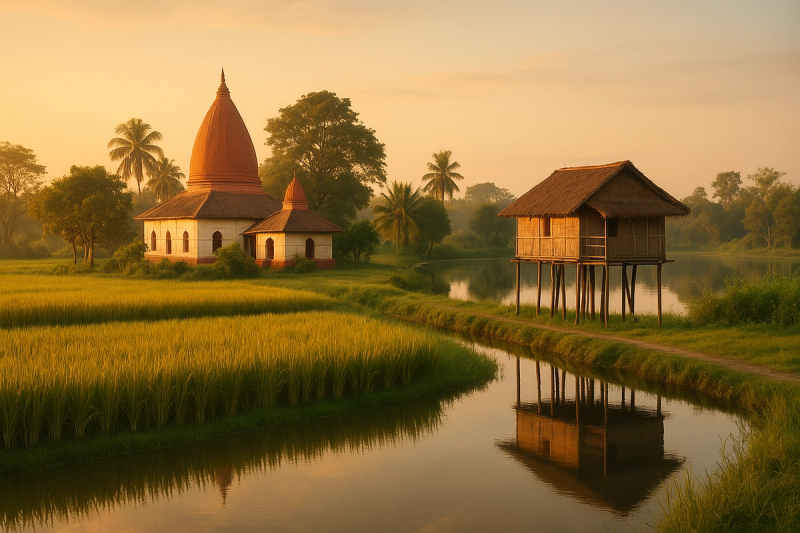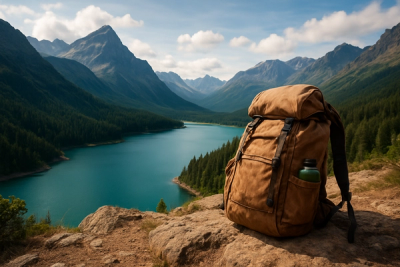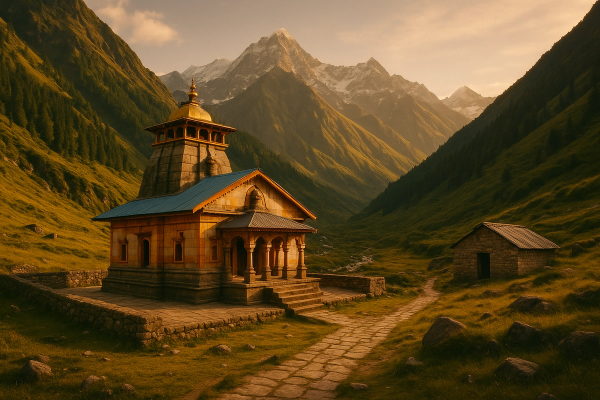Majuli Island, Assam: World's Largest River Island — my messy, beautiful trip and all the good stuff you should know#
I’ve wanted to see Majuli for years. Not in a fancy bucket-list way, just… in that stubborn, desi way where someone tells you a place is special and you keep repeating ya ya one day. Then one slightly chaotic morning, after tea so strong it could kick-start a bike, I ended up at Nimatighat near Jorhat with a small backpack, a larger appetite, and honestly, no perfect plan. Cloudy sky. Big river. The Brahmaputra feels alive, like it’s breathing slow. The ghat was busy, hawkers shouting, a kid eating orange ice lolly at 9 am (bold choice), and me trying to figure which ferry guy to trust. Ordinary scene. And then—Majuli happened. If you’ve never been on a river island this huge, with culture quietly woven into every day life, you gotta go. It’s not glossy Instagram-perfect. It’s better. It’s real.¶
Getting there (I kinda hated the ferry for 10 minutes, then loved it)#
Majuli is in the middle of the Brahmaputra, and the main access is by ferry from Nimatighat near Jorhat. You can fly into Jorhat Airport (JRH), take a cab or shared auto to the ghat, and hop onto a government Ro-Pax ferry or a passenger boat depending on water level. In the dry months, the ride is calmer, roughly 45–60 mins. Monsoon months, honestly, it can be a bit rough and sometimes delayed. As of early 2025, the Ro-Pax services have become more regular, with better adherence to life jacket rules and capacity limits. Good progress. The last ferry timing changes with season (winter sunsets are unforgiving), so don’t roll in at 4 pm and expect miracles. I freaked out initially—unexpected wind, everyone standing too close to the edge—but a calm boatman gave me a plastic stool and said, “Don’t worry, we do this everyday.” He was right. The moment the river widened, everything softened—people started chatting, someone passed around muri with mustard oil, someone else had a tiny radio playing old Assamese songs. I stopped worrying and just watched.¶
- Check ferry timings at Nimatighat. They often start early morning, but exact slots vary with season and river level. Ask at the ticket counter, not only the chai stall.
- Use government ferries whenever possible. Life jackets are available—take them. Seriously, don’t be shy.
- Carry small cash for tickets and snacks. UPI works most days, but net can drop randomly like a moody cloud.
- If water levels are crazy high or there’s a safety advisory, don’t push it. The river is not your thrill ride.
First impressions: big skies, satras, and a river that feels like it knows all the stories#
Majuli is not loud. It’s spacious. Slow. The kind of place where silence is just as present as sound. When you roll into Kamalabari Ghat, it’s not a grand welcome—no neon signs, no chaotic taxi queue—just tuk-tuks, a few cycles, some small tea shops, and that soft kind of bustle. I got on a shared e-rickshaw to Garamur, and on the way we passed green paddy fields, stilt houses with bamboo walls, kids waving with sticky hands, and satras tucked inside groves of trees. The satras are the heartbeat of Majuli—Vaishnavite monasteries established by Srimanta Sankardeva, where art and devotion feel like daily practices, not museum exhibits. The music, the prayers, the masks, the Bhaona plays—somehow earthy and divine at the same time.¶
Satras I visited and why they mattered to me (even when my feet were muddy)#
I spent a quiet afternoon at Auniati Satra—beautiful, calm, very welcoming. The museum had old manuscripts, utensils, and masks that looked alive even when they were not being worn. Kamalabari Satra felt more local-day-to-day, with people dropping in, kids running around, a gentle buzz. Dakhinpat Satra was dignified, peaceful, lined with big trees that make you wanna just sit for an hour and forget the phone exists. And then Samaguri Satra: if you’ve heard about the famous Majuli mask-making tradition, this is the one. I got lucky—I saw an artist mixing clay, cow dung, and cloth, building a face layer by layer, painting bright expressions. He let me touch the edges after they dried, and I swear I could feel that rough texture in my heart later. The masks are used during Bhaona plays and Raas—huge cultural events where stories from the life of Krishna are performed. The art isn’t just about beauty, it’s how the island keeps its culture breathing, day after day.¶
- Etiquette inside satras: remove footwear, dress modestly, keep voices low. Ask before clicking photos, especially inside prayer spaces.
- Donations are welcome but not forced. I usually put a small amount quietly and bought a couple of locally made items instead of over-clicking.
- If you catch a rehearsal for Bhaona, stay. It’ll feel like time travel without the sci-fi.
Raas festival & Bhaona: timing your trip can change everything#
If you can, visit around November for Raas Mahotsav. It’s honestly magical—three nights of performances, masks, songs, the whole island buzzing, devotees, travelers, families with sleeping kids, food stalls steaming under the cold air. But it gets crowded. Book stay early, carry warm layers, and expect late nights. Even if you don’t land exactly on Raas, Bhaona performances happen across the year at different satras, especially on auspicious days. Some are simple, some grand. I watched a small one on a regular evening—a mask with wide eyes, music on hand cymbals, the story unfolding slower than Netflix, but deeper. I didn’t expect it to move me, but it did. Funny how that works.¶
Where I stayed: homestays, bamboo cottages, and actual prices that didn’t break me#
Majuli stays are simple and good. Don’t expect marble bathtubs and infinity pools. Expect clean rooms, mosquito nets, woven mats, warm hospitality, and sometimes a friendly dog sleeping under your chair. I stayed at a homestay near Garamur, and later a bamboo cottage by a pond—no lavish stuff, but everything was cared for. Typical prices? Budget homestays can be around ₹800–₹1,200 per night, mid-range cottages or eco-stays go for ₹1,500–₹3,000. A few places sometimes push higher if it’s peak season or they have attached restaurant setups. If you want specific names, folks commonly mention La Maison de Ananda, some eco-camps and cottages near Kamalabari-Garamur side, and small family-run guesthouses around villages. Book by phone or WhatsApp—many places aren’t aggressively listed online. Electricity can flicker, but it’s fine. Network is decent near market areas; it drops at weird moments like right before you try to UPI the tea guy. Carry cash. Also, nights are quieter than city folks expect—no long nightlife, thank god.¶
- During Raas or school holidays, book 2–3 weeks ahead. Some stays literally fill up overnight.
- Carry a light shawl even if you think you’re tough. Night breeze on an open river island is a sneaky ninja.
- Ask for local breakfasts—pitha, jolpan, seasonal pickles. You’ll stop craving hotel buffet stuff real quick.
Food on the island: thalis, apong, and one fish tenga that made a rainy day feel better#
Assamese food is comfort. In Majuli, even more so. A basic thali with rice, dal, stir-fried greens (lai xaak if you’re lucky), aloo pitika (mashed potato with mustard oil), fish tenga with ou tenga (elephant apple) for that tang, maybe black sesame—clean flavors, nothing overdone. Mising community food is a highlight—pork with bamboo shoot, smoked fish, and apong (rice beer). Ask respectfully, some homes brew, some small places serve during meals. Don’t be weird, drink responsibly. Vegetarian food? Easy. Tons of greens, simple dals, seasonal veggies. For sweets, look out for local pithas and paya some mornings—these things vanish fast so pls don’t delay. Price-wise: thalis around ₹180–₹250 in local eateries; special fish dishes might go ₹300+ depending on type and portion. There’s also dry fish chutneys that are intense in a good way. One rainy day I sat under a tin roof, spooning fish tenga with steam fogging my glasses, and genuinely thought—why did I wait so long to come here?¶
Cycling around and tiny adventures that just happen#
Majuli is perfect for slow wheels. I rented a cycle for ₹150 a day. If you’re not in the mood to pedal, e-rickshaws (totos) are everywhere and scooters go for ₹400–₹600 per day if you ask around. Roads: some smooth, some bumpy, all scenic. Morning rides along paddy fields with egrets stalking like tiny white ghosts—gorgeous. Sunset at a chapori (sandbank) was a surprise… orange-yellow light on sand ripples, fishermen packing nets, kids kicking a ball that kept sinking, and me counting clouds because why not. Salmora side has traditional pottery—handmade without a wheel, using locally sourced clay, fired carefully. It’s skill passed through generations. Buy something small, a bowl or lamp, don’t bargain to death. You can also drop by weaving clusters—textiles with simple, earthy designs that feel like they were made with patience.¶
- Less-touristy picks: Salmora pottery village, mask workshop at Samaguri Satra, birding near beels (wetlands) at dawn, weaving lanes around Lakhimi/Garamur side, and random chapori sunsets if the river permits.
- If you wake early, watch boats slide like shadows. It’s like meditation without trying.
Practical stuff that actually matters: seasons, floods, safety, money, phones#
Best months: October to March. Clear skies, pleasant days, cool nights. April–May gets warm but manageable. June onwards, heavy monsoon and floods can happen. Erosion is real in some pockets—don’t walk near crumbling edges even if your selfie wants drama. Safety-wise, stick to regulated ferries, wear life jackets, and listen to crew instructions. If there’s any advisory from Inland Water Transport (IWT) Assam or local authorities, follow it. Bring a mosquito repellent—no need to panic about malaria, but bites are annoying as hell. Money: SBI/other bank ATMs in Garamur side usually work, but plan for cash anyway. UPI is common at tea stalls and small eateries but drops randomly. Phones: network is ok near markets, patchy in fields, and dead flat sometimes by wetlands. That’s alright. It makes conversation weirdly better.¶
Latest updates & what’s changing (less chaos, more comfort)#
Ferry infrastructure’s improving—newer Ro-Pax vessels, better life jacket compliance, more predictable schedules in the dry months. E-rickshaws have exploded in a good way—eco-friendlier, quiet, cheap. Some satras now have organized museum spaces with better signage—bless whoever did that. Plastic use is being discouraged more aggressively, especially at cultural sites. There’s talk of the big river bridge from Jorhat side—work has been ongoing, timelines have shifted, and locals say it’ll change daily life significantly. Could be a game changer, but don’t plan your trip assuming the bridge tomorrow. Also, homestays and eco-stays are focusing on simple sustainability—rainwater collection, compost, local sourcing. Tour guides? Small community-based guides are easier to find now. Honest tip: hire them for at least half a day if you want stories beyond Google.¶
Costs I actually paid (approx, so you don’t get fooled by random quotes)#
- Ferry: ₹30–₹100 per person depending on boat type. Ro-Pax with a scooter/vehicle extra.
- Cycle rental: ₹100–₹200 per day (haggle lightly, don’t be that person).
- E-rickshaw: ₹20–₹30 per km or flat rates for point-to-point.
- Homestay: ₹800–₹1,500 for clean basic rooms; eco-cottages ₹1,500–₹3,000.
- Thali meals: ₹180–₹250; fish/pork dishes can be ₹250–₹400 based on cut and place.
- Guide for half-day: ₹600–₹1,000 depending on route and language. Worth it.
- Mask workshop donation or small ticket: ₹50–₹200. Buy a souvenir if possible.
- Local textiles: small items ₹300–₹800; bigger pieces obviously more.
Things that caught me off guard (and how you can not repeat my mistakes)#
I didn’t expect the ghat to “shift”. In flood season, landing points can move a little along the bank, so ask around and follow local directions. I also thought shops would be open late. Nope. Nights get quiet. Eat dinner early or carry snacks—my emergency peanuts saved me twice. Network went off mid-transaction once; the uncle said just sit and drink tea, it’ll come back… it did. Bring a torch or use your phone light; some lanes are properly dark. Lastly, don’t try to see every satra in one day. Your brain will blur. Pick 2–3, sit, listen, let the place breathe. Majuli is not for checklist travel. It’s for that slower thing we keep forgetting to do—being present.¶
Respect the island: people, culture, environment—basically don’t be annoying#
Satras are sacred. Dress appropriately, be patient, and don’t shove cameras into faces mid-prayer. Alcohol—avoid around satras and be discreet always. The island is fighting erosion; don’t litter, don’t drive on sensitive sandbanks, and don’t collect random “cool stones” from river edges. Ask permission before photographing artisans. When you buy pottery or textiles, pay fair, not exploitatively cheap. This island is soft-spoken. It gives alot without asking for attention. Let’s not be loud tourists who disturb that balance. Also, try local transport and small eateries instead of hunting big-brand stuff—it keeps money circulating locally.¶
A flexible 2–3 day plan that worked for me (adjust to mood, river, and tea)#
- Day 1: Arrive via Nimatighat ferry to Kamalabari, settle near Garamur. Visit Auniati Satra and Kamalabari Satra. Evening walk to market, eat simple thali.
- Day 2: Morning cycle to Samaguri Satra for mask-making, spend time actually watching the craft. Lunch with local Mising-style food if available. Late afternoon to a chapori for sunset, then early dinner.
- Day 3: Salmora pottery side and weaving lanes. Birding near beels at dawn if you’re keen. Chill. Back to ghat with buffer time for ferry.
The best part was always the slow moments: tea by a bamboo fence, someone telling a story that didn’t quite end, wind making the prayer flags whisper.
Latest travel updates & safety checks before you go (worth 3 mins, trust me)#
Before travelling, check with Inland Water Transport (IWT) Assam for ferry advisories and timings—changes happen with river mood. During peak monsoon, keep an eye on local news for flood updates and shifting ghats. Carry basic meds, sunscreen, and a cap—sun plus wind equals sneaky tan. If you’re going during Raas, prebook stays and transport; traffic in Jorhat gets tight. Signal and payments can be patchy, so print or save screenshots of booking confirmations. Also, if the bridge work updates are in the news again, cool, but don’t rely on that for your immediate plan. You’ll be fine with ferries if you plan ahead and don’t arrive last minute like me and him did on day one.¶
Would I go back?#
Yes. 100%. Majuli isn’t one of those places you tick and move on. It’s more like a song you revisit when your brain is crowded. I liked how time stretches there—how mornings feel fresh and bigger, how evenings can be quiet without being lonely. I’d go back for Raas, for mask-making, for simple lunches with fish tenga, and honestly just to sit under a tree at a satra and let my mind wander. Also I want to buy more pottery and not break it on the way home again—long story.¶
Quick tips from one clumsy traveler to another#
- Keep a small day pack with water, cash, a light shawl, and mosquito repellent. Solid starter kit.
- Don’t schedule tight ferry-to-flight connections in Jorhat. Buffer time saves tears.
- Talk to people—shopkeepers, boatmen, satra caretakers. They’ll guide you better than any app.
- Eat where it smells like mustard oil and fresh greens. You’ll rarely go wrong.
- Slow down. You won’t “finish” Majuli. It’ll finish your rush, and that’s better.
Final thoughts and where to read more#
Majuli Island is called the world’s largest river island for a reason, but the size is not what stays with you. It’s the feeling—soft sounds, patient art, water always nearby, people who smile even when you ask silly questions. I left with mud on my shoes and that lightness in chest you only get when a place has been kind to you. If you want more travel stories, practical guides, or honestly just to find inspo for your next trip, you can check AllBlogs.in. I keep stumbling on good itineraries there when I’m stuck in office mode. Anyway, if you’ve been thinking about Majuli, go. Don’t overthink. Pack light, bring respect, and let the river do the rest.¶














